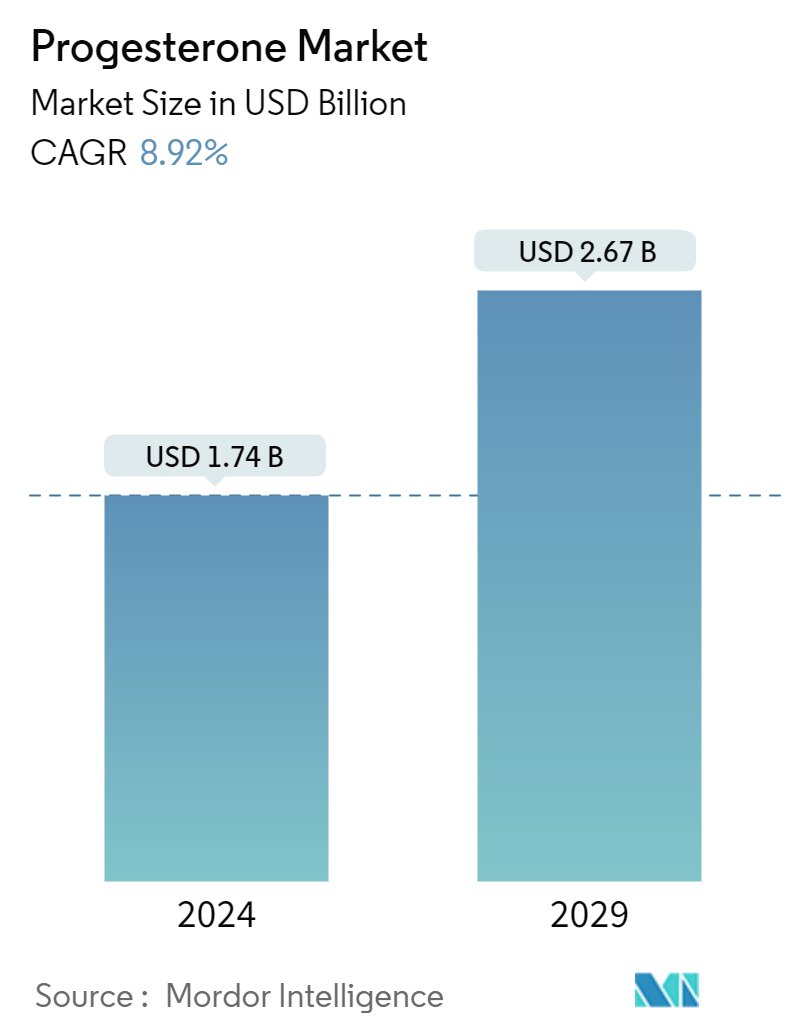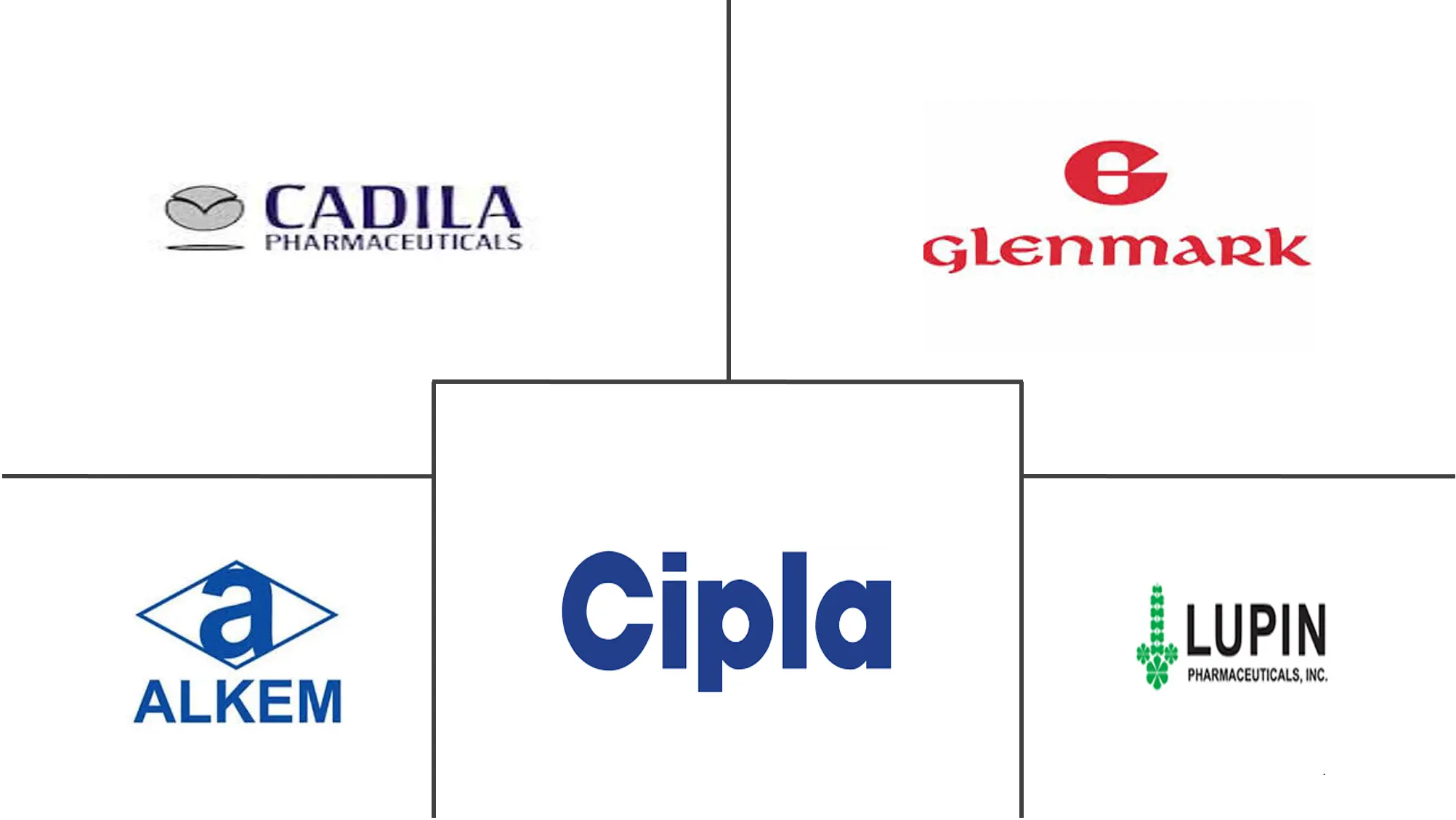Market Size of Progesterone Industry

| Study Period | 2019 - 2029 |
| Market Size (2024) | USD 1.74 Billion |
| Market Size (2029) | USD 2.67 Billion |
| CAGR (2024 - 2029) | 8.92 % |
| Fastest Growing Market | Asia Pacific |
| Largest Market | North America |
Major Players
*Disclaimer: Major Players sorted in no particular order |
Progesterone Market Analysis
The Progesterone Market size is estimated at USD 1.74 billion in 2024, and is expected to reach USD 2.67 billion by 2029, growing at a CAGR of 8.92% during the forecast period (2024-2029).
COVID-19 had a considerable impact on the growth of the market. This is due to the effectiveness of progesterone treatment in reducing the severity of COVID-19-infected patients. In March 2021, the pilot clinical trial conducted at Cedars-Sinai Medical Center, which included 40 men, published that the use of progesterone to treat male COVID-19 patients may improve clinical outcomes for certain hospitalized men. Such studies increased the demand for progesterone treatment, thereby contributing to the market's growth during the pandemic. However, the demand for progesterone is expected to grow in the current market scenario due to the rising focus on target disorders, thereby contributing to the market's growth over the forecast period.
Rising disorders, such as abnormal uterine bleeding, menopause, endometrial cancer, hyperplastic precursor lesions, amenorrhea, and the female population suffering from these diseases, are also expected to promote growth. For instance, according to an NCBI article published in June 2021, secondary amenorrhea, occurs in approximately 3-5% of adult women globally. The report also mentioned that functional hypothalamic amenorrhea accounted for 20-30% of secondary amenorrhea cases and 3% of primary amenorrhea. Also, the NCBI article published in September 2022 mentioned that up to one-third of women will experience abnormal bleeding in their life with irregularities most commonly at menarche and menopause.
In addition, an upsurge in the incidence of breast cancer in women is anticipated to be a key growth factor, as the patient pool of breast cancer may suffer from breast tenderness, where the progesterone hormone is considered one of the treatment options. According to IARC data published in 2020, about 2.2 million new cases of breast cancer were reported across the world and were estimated to reach 3 million by 2040. Such an increase in breast cancer across the world is expected to contribute to the growth of the market over the forecast period.
The growing demand for progesterone is driven by the presence of routinely monitored formulations, technological advancements in the field of drug delivery systems, and increasing awareness among patients. Additionally, increasing product developments to meet the growing demand for progesterone are also expected to fuel the market growth. For instance, in February 2020, Besins Healthcare launched the production of Utrozhestan (progesterone) drug in Russia at the facilities of its local plant in the Yaroslavl region.
While there is an expectation for the market to experience strong growth, the lack of awareness regarding the availability of progesterone therapy in developing regions and the side effects of the therapy may restrict the market.
Progesterone Industry Segmentation
Progesterone is the naturally occurring steroid hormone that is produced in the adrenal glands, ovary, and placenta. Progesterone is mainly involved in the maintenance of pregnancy, regulation of the menstrual cycle, and embryogenesis. Low progesterone levels may lead to constant breast tenderness, abdominal pain, fatigue, and even miscarriage or fetal death. During this phase, progesterone is given to the patient to prevent the aforementioned conditions. The Progesterone Market is segmented by Product Type (Natural and Synthetic Progesterone), Mode of Delivery(Injectable, Suspended form, Oral, and Other Modes of Delivery), Application( Menopause, Dysfunctional Uterine Bleeding, Endometrial Cancer, Contraception, Hyperplastic Precursor Lesions and Other Applications), and Geography (North America, Europe, Asia-Pacific, Middle East and Africa, and South America). The market report also covers the estimated market sizes and trends for 17 different countries across major regions globally. The report offers the value (in USD million) for the above segments.
| By Product Type | |
| Natural Progesterone | |
| Synthetic Progesterone |
| By Mode of Delivery | |
| Injectable | |
| Suspended Form | |
| Oral | |
| Other Modes of Delivery |
| By Application | |
| Menopause | |
| Dysfunctional Uterine Bleeding | |
| Endometrial Cancer | |
| Contraception | |
| Hyperplastic Precursor Lesions | |
| Other Applications |
| Geography | ||||||||
| ||||||||
| ||||||||
| ||||||||
| ||||||||
|
Progesterone Market Size Summary
The progesterone market is poised for significant growth, driven by increasing awareness and demand for treatments addressing various hormonal and reproductive health disorders. The market's expansion is further fueled by the rising incidence of conditions such as abnormal uterine bleeding, menopause-related issues, and endometrial cancer, which necessitate progesterone-based therapies. The COVID-19 pandemic also played a role in boosting market demand, as studies highlighted the potential benefits of progesterone in improving outcomes for certain COVID-19 patients. Technological advancements in drug delivery systems and the introduction of new formulations are expected to enhance market growth, with natural progesterone products gaining traction due to their favorable patient outcomes and prescription rates.
North America is anticipated to hold a substantial share of the progesterone market, attributed to the region's advanced healthcare infrastructure and high disease burden, including a significant number of cancer cases. The increasing prevalence of breast and uterine cancers, along with a growing population of menopausal women, is expected to drive demand for progesterone therapies. The market is characterized by its fragmented nature, with numerous global and regional players actively participating. Companies such as Alkem Labs, Cipla Limited, and Sun Pharma are notable contributors, with recent product launches and regulatory approvals further bolstering market dynamics. Despite the promising growth prospects, challenges such as limited awareness in developing regions and potential side effects of therapy may pose constraints to market expansion.
Progesterone Market Size - Table of Contents
-
1. MARKET DYNAMICS
-
1.1 Market Overview
-
1.2 Market Drivers
-
1.2.1 Rise in the Incidence of Amenorrhea and Uterine Rupture
-
1.2.2 Increase in Cases of Female Infertility and Breast Cancer
-
1.2.3 Technological Advancements in the Medical Industry
-
-
1.3 Market Restraints
-
1.3.1 Lack of Awareness Regarding the Availability of Hormone Therapy
-
1.3.2 Side Effects of Progesterone
-
-
1.4 Porter's Five Forces Analysis
-
1.4.1 Threat of New Entrants
-
1.4.2 Bargaining Power of Buyers/Consumers
-
1.4.3 Bargaining Power of Suppliers
-
1.4.4 Threat of Substitute Products
-
1.4.5 Intensity of Competitive Rivalry
-
-
-
2. MARKET SEGMENTATION (Market Size by Value - USD million)
-
2.1 By Product Type
-
2.1.1 Natural Progesterone
-
2.1.2 Synthetic Progesterone
-
-
2.2 By Mode of Delivery
-
2.2.1 Injectable
-
2.2.2 Suspended Form
-
2.2.3 Oral
-
2.2.4 Other Modes of Delivery
-
-
2.3 By Application
-
2.3.1 Menopause
-
2.3.2 Dysfunctional Uterine Bleeding
-
2.3.3 Endometrial Cancer
-
2.3.4 Contraception
-
2.3.5 Hyperplastic Precursor Lesions
-
2.3.6 Other Applications
-
-
2.4 Geography
-
2.4.1 North America
-
2.4.1.1 United States
-
2.4.1.2 Canada
-
2.4.1.3 Mexico
-
-
2.4.2 Europe
-
2.4.2.1 Germany
-
2.4.2.2 United Kingdom
-
2.4.2.3 France
-
2.4.2.4 Italy
-
2.4.2.5 Spain
-
2.4.2.6 Rest of Europe
-
-
2.4.3 Asia-Pacific
-
2.4.3.1 China
-
2.4.3.2 Japan
-
2.4.3.3 India
-
2.4.3.4 Australia
-
2.4.3.5 South Korea
-
2.4.3.6 Rest of Asia-Pacific
-
-
2.4.4 Middle East and Africa
-
2.4.4.1 GCC
-
2.4.4.2 South Africa
-
2.4.4.3 Rest of Middle East and Africa
-
-
2.4.5 South America
-
2.4.5.1 Brazil
-
2.4.5.2 Argentina
-
2.4.5.3 Rest of South America
-
-
-
Progesterone Market Size FAQs
How big is the Progesterone Market?
The Progesterone Market size is expected to reach USD 1.74 billion in 2024 and grow at a CAGR of 8.92% to reach USD 2.67 billion by 2029.
What is the current Progesterone Market size?
In 2024, the Progesterone Market size is expected to reach USD 1.74 billion.

